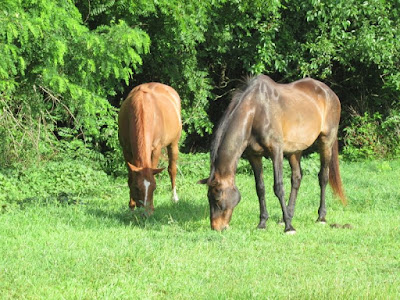Sunday, June 28, 2020
Sunday Stills
Wednesday, June 24, 2020
Understanding Hay Test Results, Dry Matter and Energy
Sunday, June 21, 2020
Sunday Stills
Wednesday, June 17, 2020
Understanding Hay Test Results, Part One
(post by Jason) Since we got our hay tests back today I am going to begin sharing some of the information we use to evaluate the forage portion of our horse diets. That’s the first and most fundamental step in designing a grain and mineral ration that complements your forage and thus *really* balances the diet. I’m not kidding or exaggerating when I say that each line of the hay test shown below could easily turn into a blog post.
Equine enthusiasts tend to focus heavily on the level of crude protein and the mineral levels in hay, particularly calcium and phosphorus. I’m not going to dismiss either minerals or protein level out of hand, but I am going to relegate both to another blog post because, in my opinion, they are the least important, or the most easily correctable (and in the case of minerals probably the least accurate) numbers on this test. Instead in today’s post I am going to focus on digestibility. Those numbers are represented by ADF, NDF. In my next post I am going to talk about energy levels. When I’m through with digestibility and energy I will come back and deal with protein and minerals in a third blog post. Then I’ll put it all together and (hopefully) show you what a balanced horse diet looks like.
ADF stands for Acid Detergent Fibre and NDF stands for Neutral Detergent Fibre. These names are nonsensical to the average layman; they are short merely forms of the chemical assay process used to measure the fibre fraction of forages. What you need to know is that ADF measures digestible fibre, cellulose and hemicellulose. NDF measures digestible AND indigestible fibre, cellulose, hemicellulose and lignin.
Let’s talk first about digestibility. It might be easiest to think about digestibility as a ratio. If there are 100 parts in total of nutrient X in a forage, and that forage is 90% digestible,that means 90 parts of nutrient X are available to get used by the horse and 10% pass right through the horse and out the other end in the form of liquid or solid excreta. If another forage containing the same 100 parts of nutrient X were only 60% digestible, the horse would get significantly less of nutrient X per pound/kilogram of forage consumed and a lot more of nutrient X would pass through the horse and out in it’s excreta.
I wish we had models that predicted digestibility this accurately for every nutrient. Unfortunately we don’t. Instead we measure digestibility indirectly using ADF and NDF. ADF contains cellulose and hemicellulose which are digestible fibre fractions. NDF contains cellulose and hemicellulose too, but it also contains lignin which isn’t digestible at all. Generally speaking and up to a point, lower levels of ADF and NDF equate to higher digestibility of all nutrients. Higher levels of ADF and NDF equate to lower levels of digestibility. In terms of grassy horse hay “good to excellent” digestibility may be represented by numbers like ADF 30% and NDF 50% on an as fed basis. Remember when you look at these numbers they’re measuring fibre levels NOT direct digestibility of any nutrient! As fed numbers with ADF >45% and NDF >65% mean that nutrient digestibility is poor for horses. If you see hay with as fed numbers higher than that I would certainly think twice about buying it for anything except very easy keepers.
I’m quite pleased with the ADF and NDF numbers (31.3 and 52.8 respectively) in this batch of hay. It means the nutrients contained within it are going to be quite bioavailable to the horse.
Fibre numbers also play a role in how acidic a horse’s gut become which is why I used the caveat that lower ADF and NDF numbers in stored forages were good only up to a point. Beyond that point there is too little fibre in the diet to offset acid production and it’s entirely possible to create a situation that promotes hindgut acidosis and all the maladies that brings with it. Most often this happens when grazing cool season grasses (particularly when said grasses contain a lot of cool season legumes) up north in the early and mid spring AND you’re not feeding enough/any hay to buffer the rocket fuel the horses are eating. This is exactly why we keep good quality hay in our hay feeders through much of the spring. The good news is that if you’re feeding long stemmed grass hay as your major forage source there is a much reduced chance of creating a situation where there is too little fibre in the diet.






































































